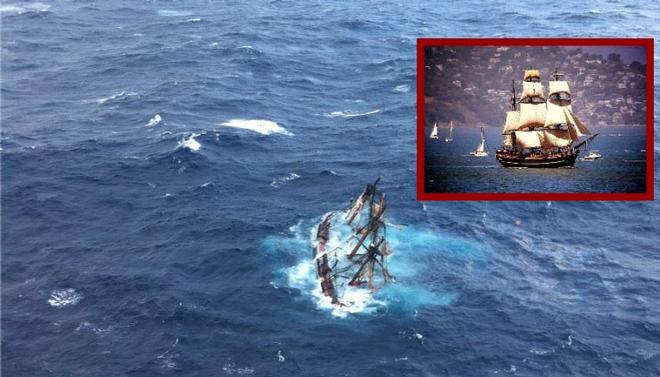It's official- Final word on Bounty, the Captain's 'reckless decision'
by Sail-World Cruising round-up on 12 Feb 2014

Bounty as she proudly was, and the tragic sight of her sinking SW
They didn't mince their words. 'The US National Transportation Safety Board determines that the probable cause of the sinking of tall ship Bounty was the captain's reckless decision to sail the vessel into the well forecasted path of Hurricane Sandy, which subjected the aging vessel and the inexperienced crew to conditions from which the vessel could not recover. Contributing to the sinking was the lack of effective safety oversight by the vessel organization.'
This was the final damning report about the tragic sinking of the Bounty in October 2012, in which the blamed captain and one other crew member died and three others were seriously injured.
On the evening of October 25, a day after a well-forecast developing storm had reached hurricane strength, the 108-foot-long tall wooden ship, the Bounty, set sail from New London, Connecticut for St. Petersburg in Florida, into the forecasted path of Superstorm Sandy. The 52-year-old vessel, a replica of the original 18th Century British ship of the same name, had been built for the 1962 movie, 'Mutiny on the Bounty', and had become a familiar sight on the east coast of America and in the Caribbean
Prior to setting off from New London, some of the crew members had expressed their concerns to the captain that sailing into a severe storm could put all of them and the ship at risk. The captain assured the crew that the Bounty could handle the rough seas and that the voyage would be a success. Just a month earlier, in an interview with a Maine TV station, the captain said that the Bounty 'chased hurricanes,' and by getting close to the eye of the storm, sailors could use hurricane winds to their advantage.
The 16-page report details how a mostly inexperienced crew - plagued by injuries, seasickness and fatigue from the 30-foot seas - continued for many hours to keep the ship's engines running and bilge pumps operating so the seawater filling the vessel would not overtake it.
However, in the early morning hours of October 29, about 110 nautical miles southeast of Cape Hatteras, North Carolina, the Bounty heeled sharply to starboard after taking on more than 10 feet of water in the final hours of the three and a half day voyage that the NTSB said, 'should never have been attempted.'
Despite hurricane winds gusting upwards of 100 mph, the U.S. Coast Guard was able to rescue all but two of the Bounty's 16 crew members by hoisting them from the sea into three Jayhawk helicopters in the midst of the storm.
The body of one crew member was found, still in a protective immersion suit, about 10 hours after rescue operations had commenced. The captain was presumed lost at sea; his body has never been recovered.
'Although this wooden ship was modelled after an 18th century vessel, the Captain had access to 21st century hurricane modelling tools that predicted the path and severity of Hurricane Sandy,' said NTSB Chairman Deborah A.P. Hersman. 'The Bounty's crew was put into an extraordinarily hazardous situation through decisions that by any measure didn't prioritise safety.'
Prior to setting to sea, the Bounty had been in a Maine shipyard for maintenance and repairs, most of which was accomplished by a crew with little experience in such specialised work. One of their tasks was to caulk and re-seam a wooden hull, which had known areas of rot, with compounds supplied by the captain, including a silicone sealant marketed for household use.
The entity that owned and operated the ship, HMS Bounty Organization, LLC, did nothing to dissuade the captain from sailing into known severe weather conditions. The NTSB said that such a lack of effective safety oversight by the vessel organization contributed to the sinking.
The entire report is available at www.ntsb.gov/investigations/fulltext/MAB1403.html.
If you want to link to this article then please use this URL: www.sail-world.com/119207